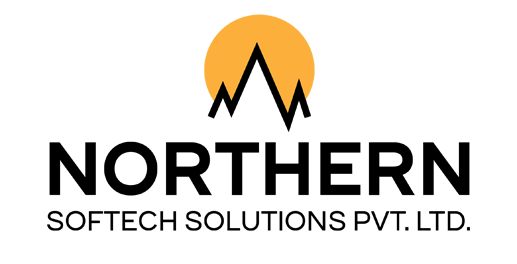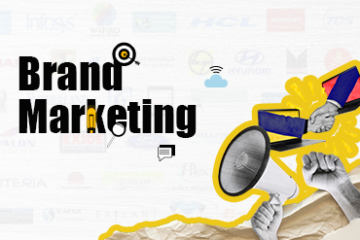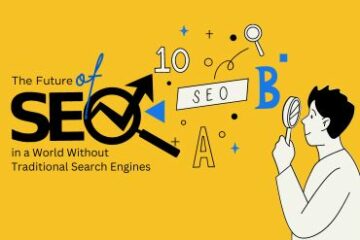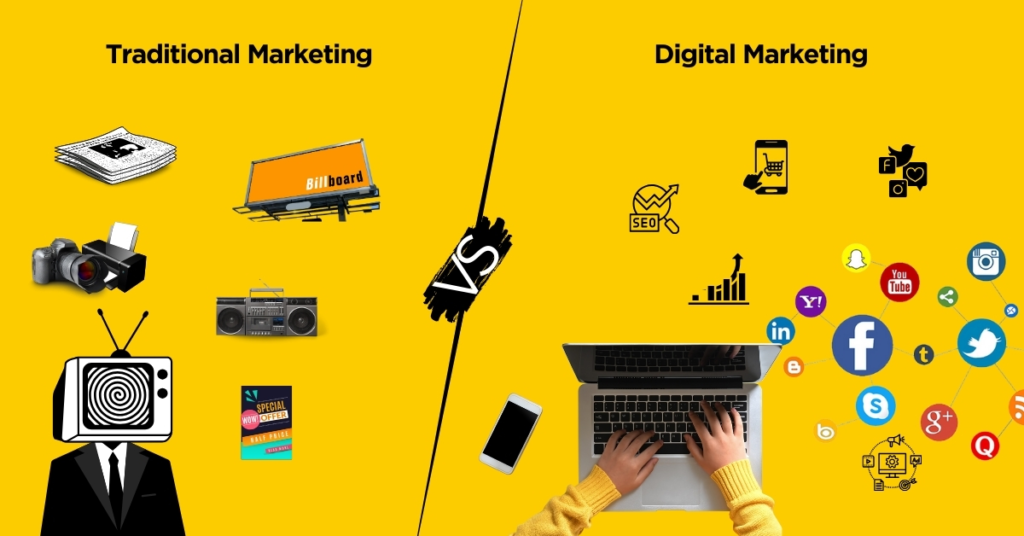
Looking forward to Digital Marketing vs. Traditional Marketing? If yes, we have got your back.
In the ever-evolving landscape of marketing, two giants stand tall, each competing for supremacy: Digital Marketing and Traditional Marketing. These two methodologies represent distinct approaches to reaching and engaging with audiences, each with its own set of strengths and weaknesses. As businesses navigate the complex landscape of consumer behavior and technological advancements, understanding the nuances and effectiveness of digital and traditional marketing strategies becomes imperative. In this comprehensive blog, we delve into the battle between Digital Marketing vs. Traditional Marketing, examining their differences, and the evolving dynamics shaping the marketing landscape. So, without further delay, let’s get started.
Table of Contents
The Rise of Digital Marketing
Before discussing Digital Marketing vs. Traditional Marketing, let’s know each term in detail. In recent decades, the digital revolution has transformed the marketing landscape, giving birth to Digital Marketing.
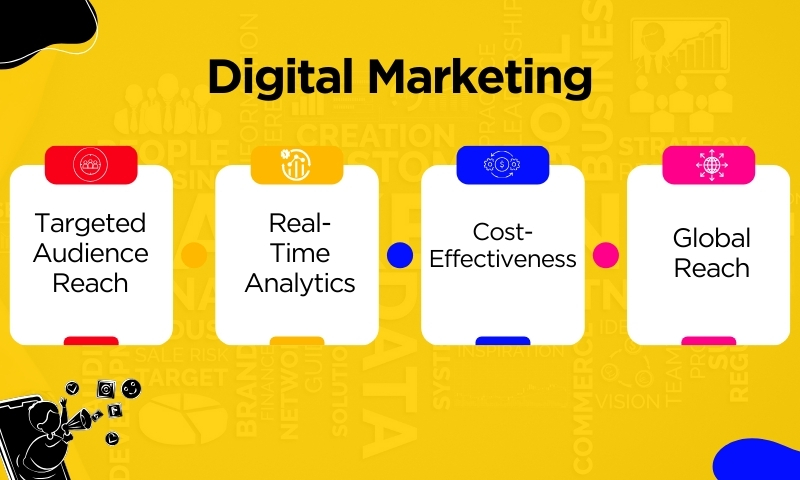
Leveraging the power of the internet, social media, mobile devices, and other digital channels, this approach offers unparalleled opportunities for targeted advertising, real-time analytics, and interactive engagement. With the ability to reach global audiences instantaneously, digital marketing has become an indispensable tool for businesses of all sizes.
Advantages of Digital Marketing
Targeted Audience Reach: Digital marketing allows for precise audience targeting based on demographics, interests, behaviors, and other parameters. Through techniques such as search engine optimization (SEO), pay-per-click (PPC) advertising, and social media marketing, businesses can tailor their messages to specific audience segments, enhancing relevance and engagement.
Real-Time Analytics: One of the significant advantages of digital marketing is the ability to track and analyze campaign performance in real time. With tools like Google Analytics, marketers can monitor key metrics such as website traffic, conversion rates, and customer behavior, enabling data-driven decision-making and continuous optimization.
Cost-Effectiveness: Compared to traditional marketing channels such as print, television, and radio advertising, digital marketing often offers lower costs and higher ROI. With options like email marketing, content marketing, and social media promotions, businesses can achieve significant reach and impact without breaking the bank.
Global Reach: The borderless nature of the Internet enables businesses to expand their reach beyond geographical boundaries. Whether targeting local markets or international audiences, digital marketing provides the flexibility to scale campaigns accordingly, driving brand awareness and customer acquisition on a global scale.
The Enduring Legacy of Traditional Marketing
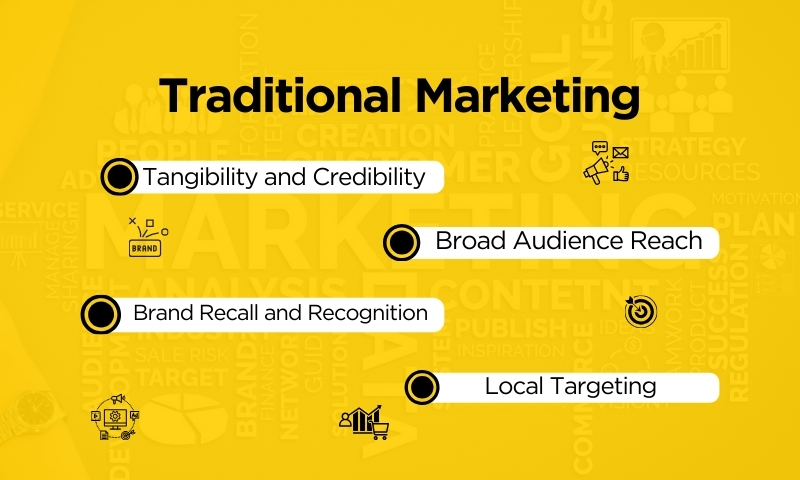
While digital marketing has garnered immense popularity and success, traditional marketing methods continue to hold relevance in the modern marketing mix. From print ads and television commercials to billboards and direct mail, these time-tested approaches offer unique benefits and opportunities for reaching diverse audiences.
Advantages of Traditional Marketing
Tangibility and Credibility: Traditional marketing channels provide a tangible presence that consumers can see, touch, and experience firsthand. Whether it’s a glossy magazine ad or a billboard along the highway, these physical manifestations convey a sense of credibility and legitimacy that digital ads may sometimes lack.
Broad Audience Reach: Traditional marketing platforms such as television, radio, and newspapers have historically enjoyed broad reach and mass appeal. For businesses targeting a wide audience or seeking to build brand awareness on a large scale, traditional media channels offer unparalleled exposure and visibility.
Brand Recall and Recognition: Traditional marketing relies heavily on repetition and frequency to reinforce brand recall and recognition. Through repeated exposure to print ads, TV commercials, and outdoor signage, consumers develop familiarity with brands, making them more likely to consider them when making purchasing decisions.
Local Targeting: For businesses operating in local or niche markets, traditional marketing channels can offer effective means of reaching target audiences. From community newspapers to local radio stations, these platforms enable hyper-targeted advertising tailored to specific geographic regions or demographic segments.
Digital Marketing vs. Traditional Marketing:
What is the Difference Between Digital Marketing and Traditional Marketing?
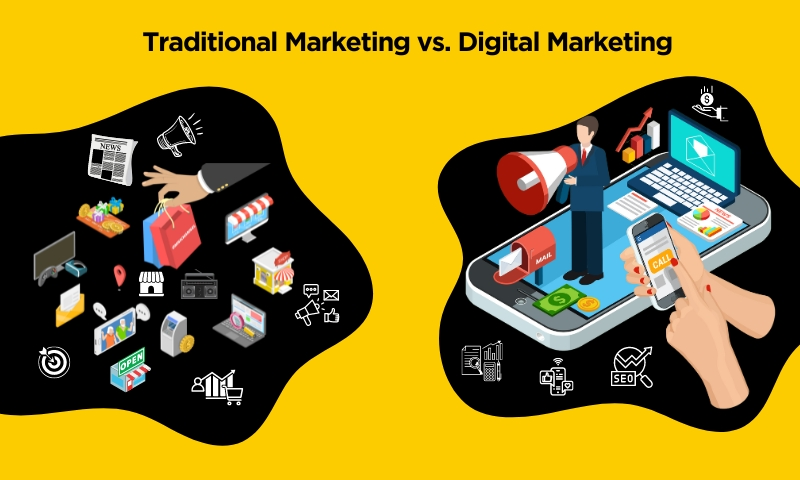
Below are some key points of difference between Digital Marketing and Traditional Marketing:
Reach and Audience Targeting
Digital Marketing: One of the best Digital Marketing vs. Traditional Marketing points is reach and audience targeting. Digital marketing offers precise audience targeting based on demographics, interests, behaviors, and other parameters. Allows businesses to reach global audiences instantaneously through online channels such as social media, search engines, and websites.
Traditional Marketing: It relies on mass media channels such as television, radio, print, and outdoor advertising for broad audience reach. Audience targeting tends to be less precise compared to digital marketing.
Cost and ROI
Digital Marketing: When it comes to the difference between traditional and digital marketing, cost is a paramount factor. Digital marketing generally offers lower costs and higher ROI compared to traditional marketing channels. Options such as email marketing, content marketing, and social media promotions can be implemented with minimal expenditure.
Traditional Marketing: This can be more expensive, especially for large-scale campaigns involving television, radio, or print advertising. ROI may be more difficult to measure accurately compared to digital marketing.
Interaction and Engagement
Digital Marketing: It provides opportunities for interactive engagement with consumers through social media interactions, online contests, quizzes, and surveys. Enables real-time communication and feedback from customers.
Traditional Marketing: It typically lacks interactivity and direct engagement with consumers. Messages are often one-way and static, without immediate avenues for feedback or interaction.
Measurability and Analytics
Digital Marketing: It offers robust tools for tracking and analyzing campaign performance in real time. Metrics such as website traffic, conversion rates, click-through rates, and engagement levels can be monitored using platforms like Google Analytics.
Traditional Marketing: Measurement of campaign effectiveness can be more challenging and less precise compared to digital marketing. Methods such as surveys, focus groups, and tracking codes may be used, but results may not be as immediate or accurate.
Flexibility and Adaptability
Digital Marketing: It allows for quick and easy adjustments to campaigns based on real-time data and feedback. Changes to ad creatives, targeting parameters, and budget allocations can be made swiftly to optimize performance.
Traditional Marketing: It typically involves longer lead times and less flexibility for making changes once campaigns are launched. Modifications may require reprinting materials or renegotiating contracts with media outlets.
Geographical Reach
Digital Marketing: It enables businesses to reach audiences globally without geographical limitations. Campaigns can be targeted to specific regions, cities, or even neighborhoods based on business objectives and target market.
Traditional Marketing: Geographical reach may be limited by the distribution and coverage of media channels. Local or regional campaigns are often more feasible and cost-effective compared to national or international campaigns.
Brand Visibility and Recall
Digital Marketing: This offers opportunities for brand visibility through online channels such as social media, search engine results, and display advertising. Brand recall may be influenced by factors such as frequency of exposure and quality of content.
Traditional Marketing: It provides a tangible presence through physical mediums such as billboards, print ads, and television commercials. Repeated exposure to mass audiences offers high visibility and potential for brand recall.
Creative Opportunities
Digital Marketing: It provides a wide range of creative options including multimedia content, interactive ads, video marketing, and immersive experiences such as augmented reality (AR) and virtual reality (VR).
Traditional Marketing: Creativity may be limited by the constraints of traditional media formats and production techniques. However, platforms such as television and print offer opportunities for visually engaging and memorable advertising campaigns.
Targeting and Personalization
Digital Marketing: Artificial Intelligence tools enable precise audience targeting and personalization based on demographics, behavior, interests, and online activities. Machine learning algorithms analyze vast amounts of data to identify patterns and preferences, allowing for the delivery of highly relevant and personalized content to individual users.
Traditional Marketing: Traditional marketing methods generally lack the level of targeting and personalization offered by digital marketing. While demographic information may inform audience segmentation, the ability to tailor messages and content to individual preferences is limited compared to digital channels.
By understanding Digital Marketing vs. Traditional Marketing, businesses can decide which marketing strategies align best with their goals, target audience, and budgetary constraints. Moreover, integrating elements from both digital and traditional marketing can often yield synergistic effects, maximizing the impact and effectiveness of overall marketing efforts.
The Evolving Terrain: Digital Marketing vs. Traditional Marketing

In today’s marketing landscape, the line between digital and traditional marketing continues to blur as businesses embrace an integrated approach to reaching consumers. Recognizing the strengths and limitations of each method, marketers are increasingly adopting hybrid strategies that leverage the best of both worlds.
Integrated Campaigns
By combining digital and traditional marketing channels, businesses can create multi-channel campaigns that maximize reach and engagement. For example, a company might launch a television ad to build brand awareness while simultaneously running targeted digital ads on social media to drive conversions.
Cross-Platform Consistency
Maintaining consistency across digital and traditional marketing platforms is essential for reinforcing brand messaging and identity. Whether through visual aesthetics, tone of voice, or key brand values, ensuring coherence across channels helps strengthen brand recall and recognition among consumers.
Omni-Channel Customer Experience
In an era of omnichannel marketing, businesses must deliver seamless and cohesive experiences across all touchpoints, both online and offline. Whether a customer interacts with a brand through a website, mobile app, retail store, or social media, the experience should be consistent, personalized, and engaging.
The Future of Marketing: Adaptation and Innovation
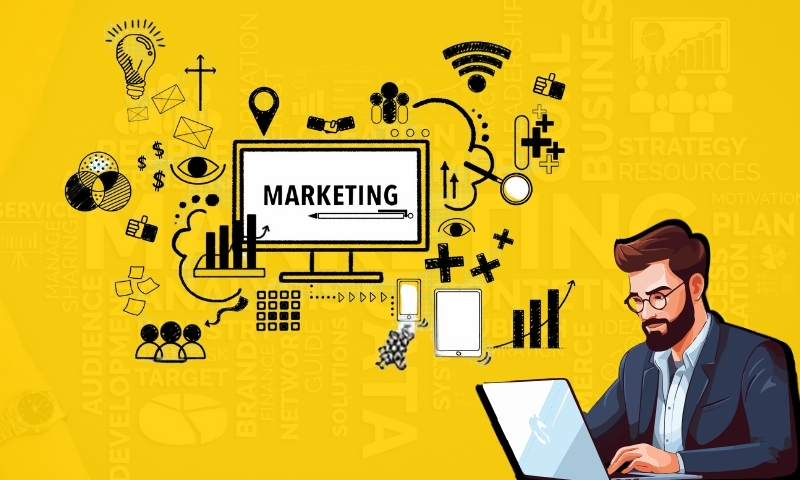
As technology continues to evolve and consumer behavior shifts, the marketing landscape will continue to undergo profound transformations. To thrive in this dynamic environment, businesses must remain agile, adaptive, and innovative in their approach to marketing.
Personalization and Customization
With advancements in data analytics and artificial intelligence, personalized marketing experiences will become increasingly prevalent. From tailored product recommendations to individualized content recommendations, businesses will leverage data-driven insights to deliver hyper-targeted messaging that resonates with consumers on a personal level.
Voice Search and AI Assistants
The rise of voice-activated devices and AI assistants like Amazon Alexa and Google Assistant presents new opportunities for marketers to optimize their content for voice search. As more consumers embrace voice-enabled technology for search and shopping, businesses will need to adapt their SEO strategies and content formats accordingly.
Conclusion
In the battle between Digital Marketing vs. Traditional Marketing, there is no clear winner. Each approach offers unique advantages and challenges, and the most successful marketing strategies often involve a combination of both. As technology continues to reshape the marketing landscape, businesses must remain agile and adaptive, embracing innovation while staying true to their core brand values and objectives. By understanding the evolving dynamics of digital and traditional marketing and leveraging the strengths of each, businesses can create impactful campaigns that resonate with consumers and drive long-term success in an increasingly competitive marketplace.
